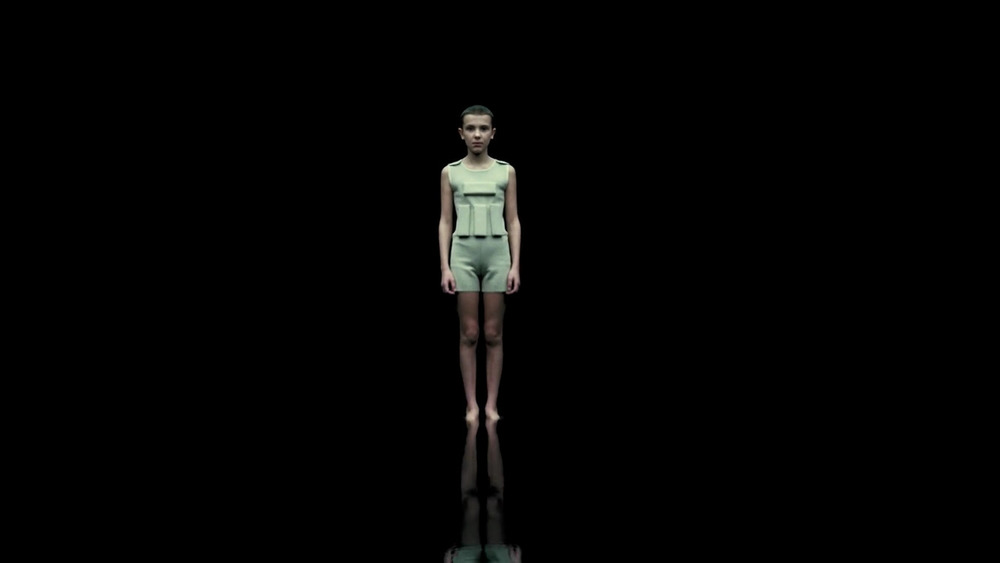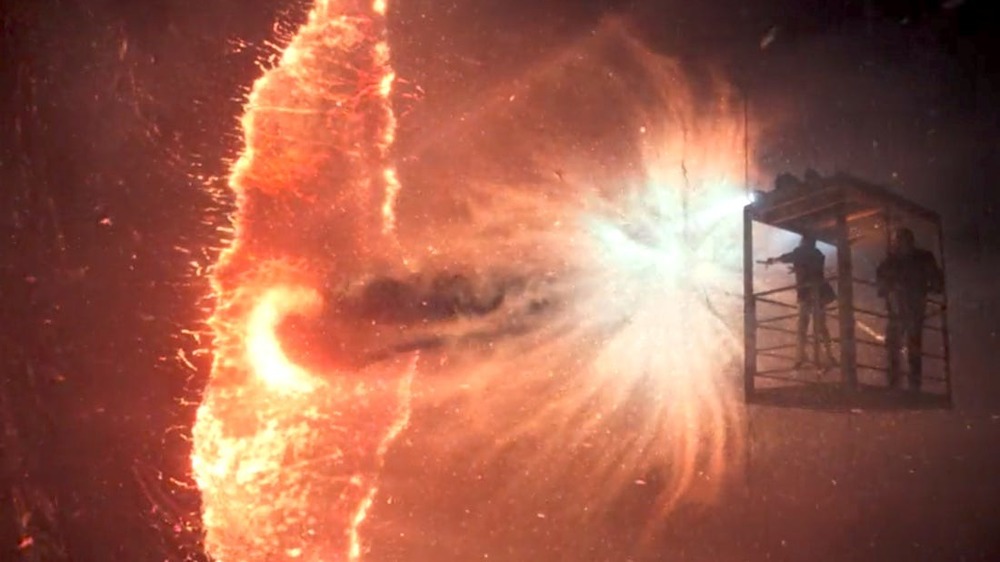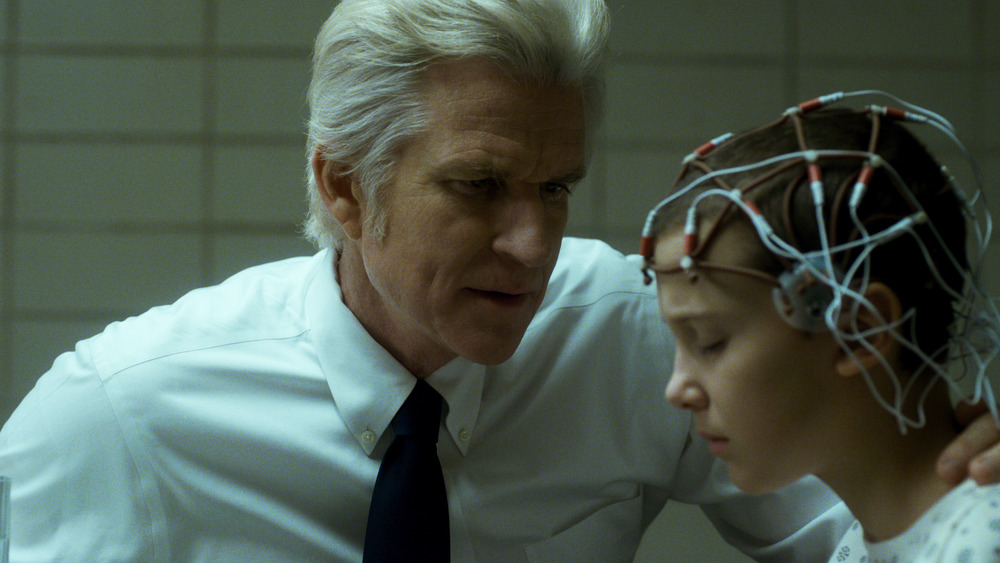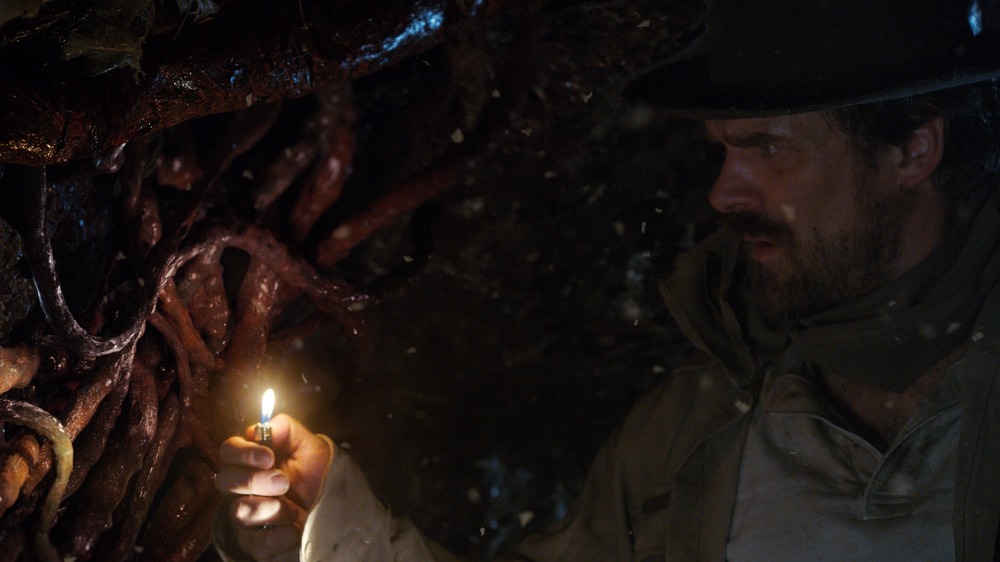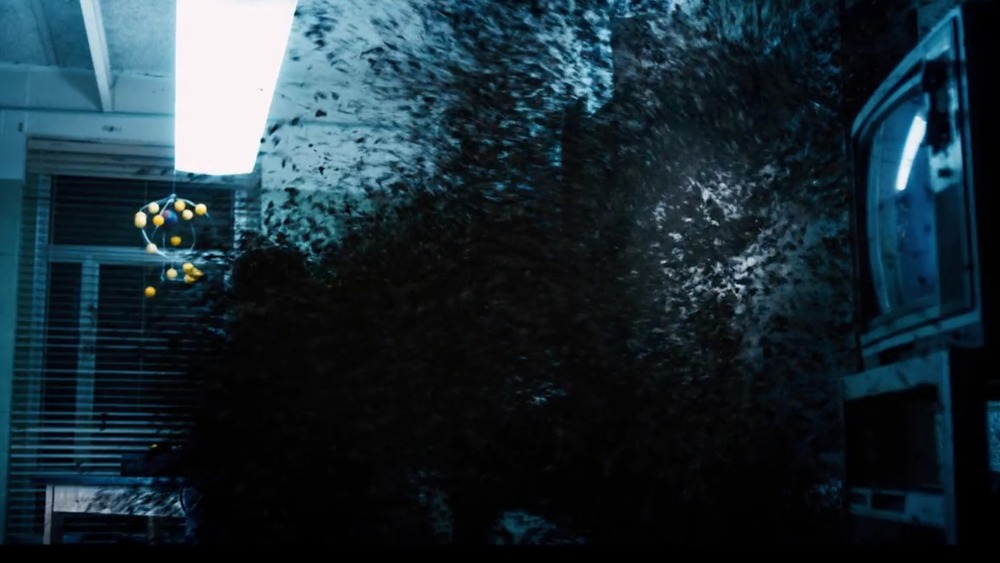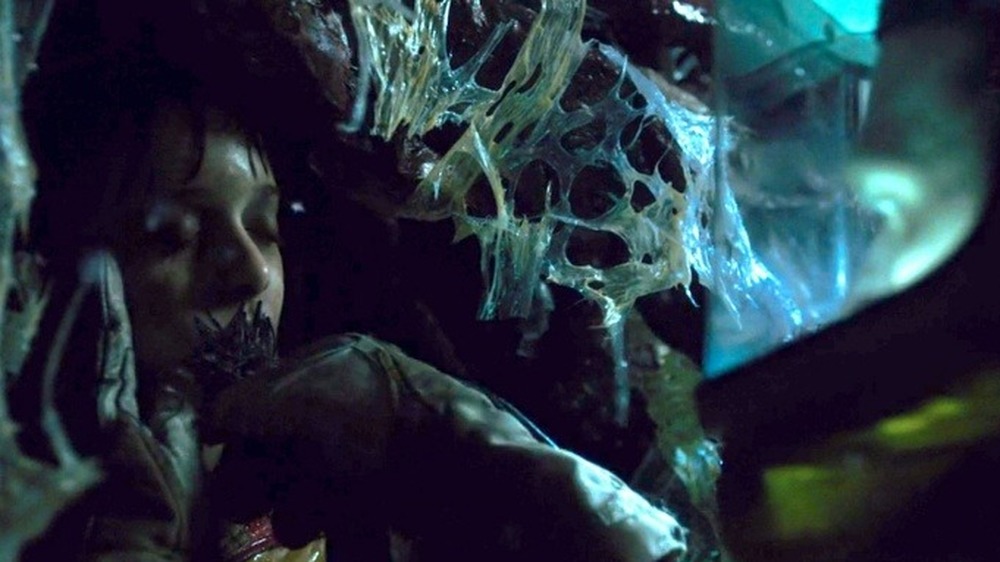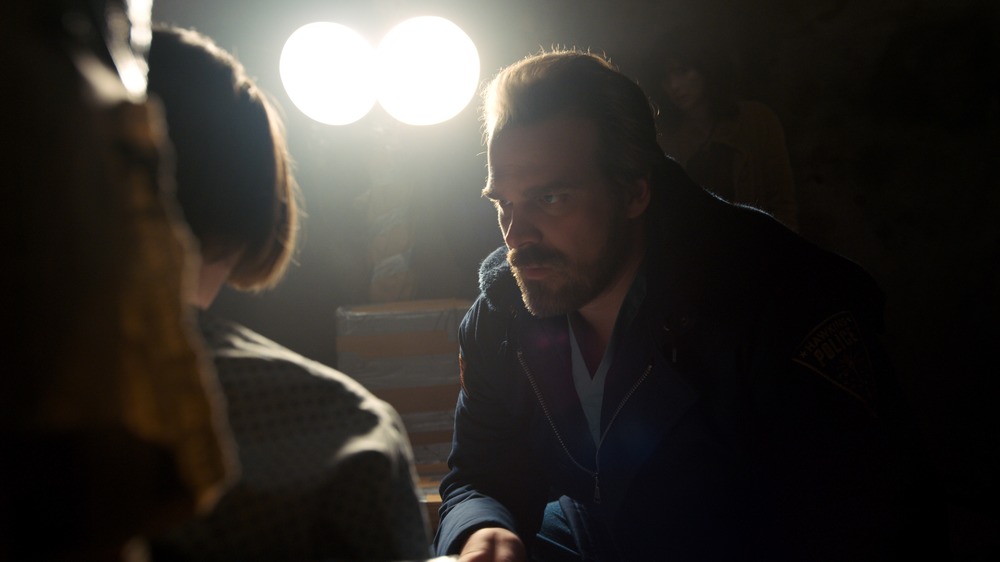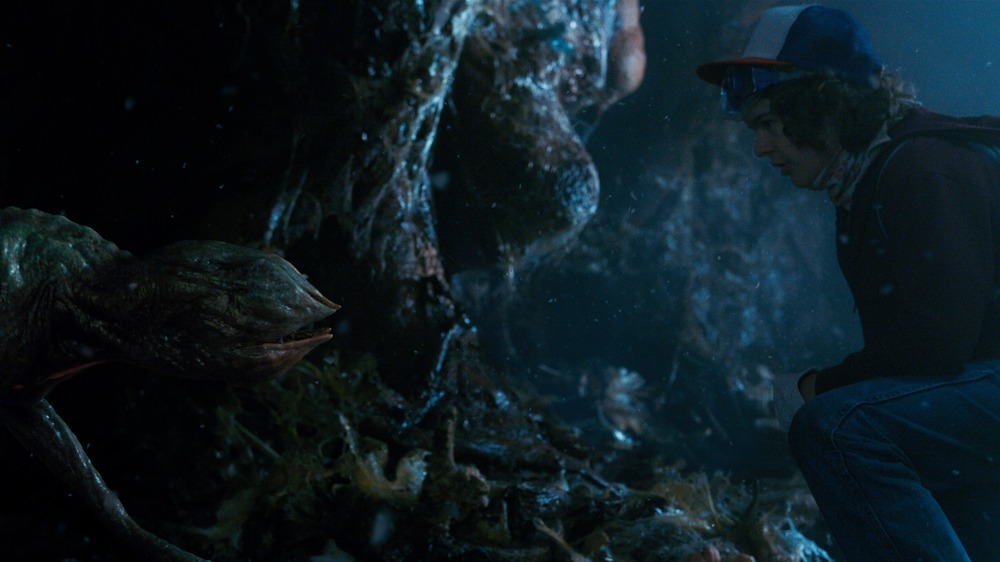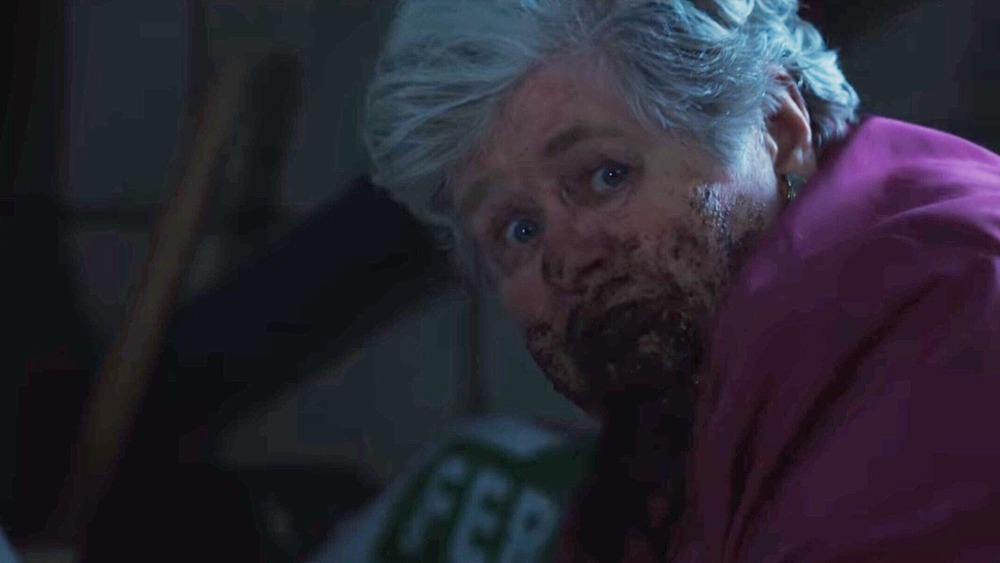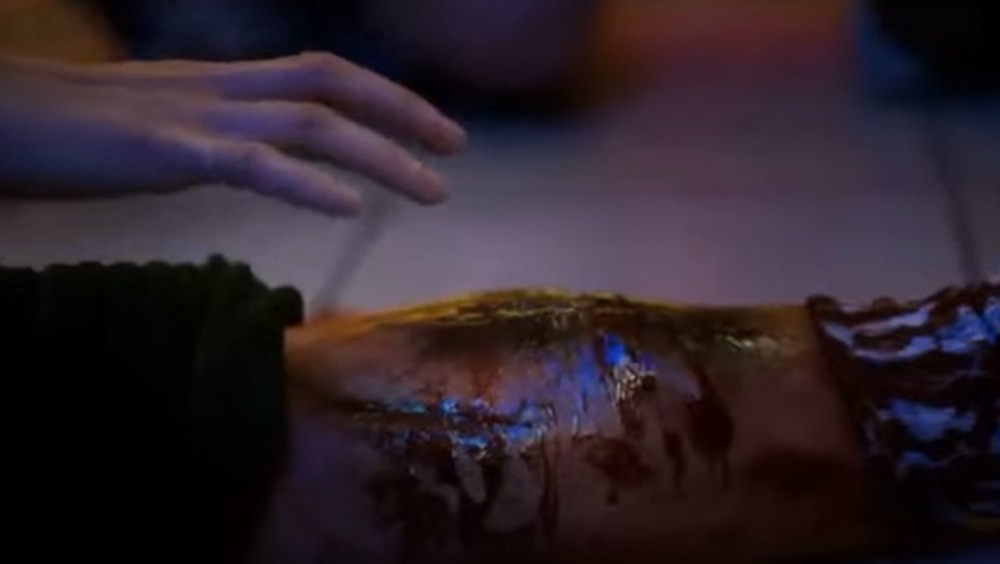The Most Confusing Moments In Stranger Things Explained
When Stranger Things premiered in 2016, it changed the media landscape. A love letter to 1980s film classics and geek culture, it ushered in rabid rewatching of the works of Steven Spielberg, Ridley Scott, John Carpenter, Stephen King, and more. Showrunners the Duffer brothers have created compelling characters in a vivid world with a labyrinthine story that phases from sci-fi to adventure to horror to comedy. Their monsters (the Demogorgon, Demodogs, and the Mind Flayer) have already become a part of our modern zeitgeist. And Eleven, the girl with the shaved head and the superpowers, leads the most likable ragtag crew of heroes since The Goonies. Which is obviously another Stranger Things influence.
But one of the most captivating elements behind this series isn't the repurposing of iconic film moments, the captivating story structure or the unforgettable characters. It's the ability to ground fantastical plot points and '80s nostalgia in real (in some cases theoretical or at least believable) science, and express very complex concepts in a way that makes sense to somebody who failed 11th grade Intro to Physics. Still, there's only so much exposition you can pack into a TV program without Neil DeGrasse Tyson. It's helpful when science teacher Scott Clarke explains necessary concepts, but those have to be kept at a minimum to keep the story moving. Some moments can still be confusing. In other cases, you may understand the principles behind a single scene, but when combined with other scenes, it may seem contradictory.
With all that in mind, here are explanations for some of the most confusing moments in Stranger Things.
How did Eleven discover the Upside Down?
The existence of a parallel dimension, the Upside Down, is the key to everything that's happened in the show so far. Eleven was in the Void (the black, wet-floored representation of her mind in psychic search mode) looking for Russians when she came across the Demogorgon. By discovering this creature from another universe and establishing a psychic connection with it, she in turn discovered the universe in which that creature lives: the Upside Down.
Since Eleven could channel her experiences in the Void over a radio, her telepathy has radio frequency. In fact, a recurring theme throughout the show is radio waves. The boys basically are the school's entire AV club, and are obsessed with radio communication. The Mind Flayer connects the creatures in its dimension telepathically, and since Eleven could see the Demogorgon, the Mind Flayer must use a radio wave similar to Eleven's. The Demogorgon's appearance, then, is like radio interference. Since Eleven's psychic Void exists without walls, it makes sense that the Upside Down's waves could make it into the Void — though they can't pass into Hawkins without a gate.
How did Eleven open the Gate to the Upside Down
When Eleven touched the monster, it noticed her. Her fear at this interaction unleashed her full power, and that psychic explosion opened the Gate. Whether El could have opened the Gate without the Demogorgon is unknown, but obviously the Mind Flayer couldn't open it without Eleven, as evidenced in season 3 when the Soviets opened it.
It's possible her powers were increased by those of the Demogorgon and that combo was needed to create the Gate. According to multiverse theory, there are many universes, so at the least she would have needed something to point her to the one holding the Demogorgon. There is another alternate universe theory, that of pocket universes, which states our observable universe can exist alongside unobservable universes. On Beyond Stranger Things episode 5, Bill Nye explained the Upside Down as a result of two overlapping universes. If either of these last two theories are more accurate, the Demogorgon would be necessary to make the Gate, akin to being able to open a door to an adjacent room since you know that other room exists.
Whether she opened it with her power alone, Eleven feels responsible and takes it on herself to close the Gate after it's been expanded by the Mind Flayer in season 2.
What is MKUltra?
In season one, Sheriff Hopper finds an article about an MKUltra scandal at Hawkins National Laboratory. This, among other related articles he finds after conducting microfiche searches in the local library, sets him onto the trail of HNL and its director, Dr. Martin Brenner. The rabbit hole leads him to Eleven's mother Terry Ives, and eventually to Eleven herself.
While Stranger Things has fictionalized the (known) results, MKUltra was an actual CIA program, started in 1953 to develop mental abilities, specifically mental abilities, as a way to fight the Soviets. Actual documents show it consisted of experiments including psychoactive drugs, electroshocks, sensory deprivation, abuse, and more. It was officially ended in 1973 and became public knowledge in 1975. Since Eleven is 12 years old in the first season of Stranger Things, which was set in 1983, Eleven would have been born in 1971, at the culmination of two decades of research and experimentation. It's plausible that a shadow cell of the program kept going long after the official program was shut down.
What are the white things floating around the Upside Down?
The Mind Flayer is a cloud of psychic energy, using organic beings to do its bidding. It might have some solid matter of its own, but all evidence points to the idea that it's mostly gaseous. So how does the Mind Flayer rule over its universe and then hope to expand that control into Hawkins? The network of organic material covering the Upside Down and then growing into the world it wants to take over, which work as superconductors for its psychic signals. And spores are one of the most basic, flexible forms of organic materials, which is how the Mind Flayer makes its vines.
These vines reach into Hawkins through the gate in seasons 1 and 2 and they extend through a tunnel system in season 2. In real-world biology, when spores gather, they create slime mold, a simple organism that attracts similar organisms chemically, as explored in a 2019 study. They combine to make a larger organism. This larger organism would be the vines which allow the Mind Flayer to keep expanding its organic conduit. The coordination between the spores and the vines is evidenced when several sporangia shoot spores at Hopper, knocking him over so the vines can wrap him up and try to kill him.
How did El end up back in the Upside Down after season 1?
At the end of season 1, El destroys a seemingly indestructible creature. To kill the Demogorgon, she has to unleash the full extent of her still-limited telepathic abilities. By the end of season 2, after her training with her sister, she's much stronger — but in season 1, she's still discovering the extent of her power. Just as her first unbridled mental explosion in conjunction with the creature opened the gate, the one aimed at disintegrating it opened a little tear between the dimensions.
Throughout season 1 we see the Demogorgon is able to create little temporary tears between dimensions, such as when it appears in Joyce Byers' wall or its opening in the tree in Mirkwood that Nancy Wheeler climbs into. Since El's powers are stronger than the Demogorgon's, it makes sense that she could inadvertently make one of these temporary tears too — especially since she opened the first gate. If you look closely during the scene, you can even see a light behind the monster that might be a new tear. When she lost total control by unleashing her full power, she created a hole through which she fell — in part because she was so close to the Demogorgon when she destroyed it.
Why does Will keep flashing back to the Upside Down in season 2?
In the last episode of Stranger Things season 1, we see a tube hooked to Will's face, similar to the facehugger from Alien. The Demogorgon, seeing Will as an incubator for more Demogorgons, dragged him back to its lair to inject him with eggs. The eggs grow into little slugs, which we later discover are Demogorgon larva. Will spits them up and washes them down the drain, but it can be assumed they act as the Mind Flayer's minions, helping to create the tunnel system. These eggs give the Mind Flayer limited access to Will Byers.
At first this is seen as a power, giving Will "True Sight" since this bit of the Mind Flayer's organic reach is enough for it to momentarily pull him back to the Upside Down — but not yet enough to fully infiltrate his mind. The Demogorgon had no motivation but to eat and reproduce, which is why it put the eggs inside Will. The Duffers said in an interview with Entertainment Weekly that the Demogorgon was inspired by Jaws — a simple creature motivated only by feeding and reproducing. When the Mind Flayer discovers that it has a connection to Will through these eggs, it begins pulling him into the Upside Down with the hope of being able to inject its essence. Once it does, it's able to infiltrate his mind.
Why does the Mind Flayer hate heat?
The Duffer brothers know the key to any monster is that it has a weakness — and the Mind Flayer's is heat. This was evidenced both in the exorcism of the Mind Flayer from Will Byers in season 2 and Billy's extreme sensitivity in season 3. However, since Stranger Things is grounded in science, there is a more scientific explanation.
The Mind Flayer's telepathic waves are similar to radio waves. Radio waves are a type of electromagnetic radiation, and magnetism gets almost as much attention as radio in the series. This electromagnetism also explains why organisms in the Upside Down affect electricity in the standard dimension, such as the flickering of lights. When you heat a magnet, its magnetic field is reduced — the particles within the magnet start moving faster and losing control, essentially "confusing" the electromagnetic waves. Since the Mind Flayer's only physical power is its ability to control its hordes using electromagnetic radio waves, it would make sense that the only "pain" it can feel is the jumbling of those waves. This also explains why the Mind Flayer can thrive in its home dimension.
A secondary reason is grounded in the spores. Spores are killed by extreme heat and vines are destroyed by burning them, so a creature whose main conduit for its power is vines created by spores would definitely be sensitive to heat.
Why did Dart let Dustin pass?
As Will explains, the Mind Flayer's mind control is like a dormant component, similar to the idea presented in The Manchurian Candidate. The Mind Flayer's control sits in its subject, dormant, until the Mind Flayer turns that control on. This is also evidenced by the Demogorgon mindlessly feeding in season 1 instead of trying to lure others to the Mind Flayer; even when it does bring a human back, the Demogorgon uses him as an incubator for eggs, not as a way to extend the Mind Flayer's power.
At the moment when Dustin and friends encounter Dart in the tunnel, it had been sent to the tunnels by the Mind Flayer. But once in the tunnels the Demodogs were left to their natural instinct to feed. Therefore Dart has the ability to make its own "decisions." When the Mind Flayer turns on its mind control, however, it has taken control of the brain, so cutting off connection with the Flayer when it's "driving the cars" kills its minions — which is why we see Dart dead at the end of season 3.
Why is the Mind Flayers' possession of people in series 3 different from its possession of Will in season 2?
In season 2, we see the Mind Flayer push its essence into Will Byers. At first it can only use Will's eyes and ears somewhat, while Will in turn is able to see what the Mind Flayer does. This is evidenced by the fact that Will can use his connection to find Hopper.
By the end, however, the Mind Flayer has figured out how to influence and then control Will — and by extension, the human mind. Also, the portion of the Mind Flayer that had been exorcised from Will was hiding in the steel mill. When the gate is reopened, that portion, a gaseous plume reminiscent of Voldemort in Harry Potter and the Sorcerer's Stone, could have gained more intel on human anatomy from the rats it was already possessing and collecting into its new host body. With this knowledge, the Mind Flayer injects more of its essence into Billy in season 3 so it quickly can control him. With the additional people it flays, the Mind Flayer gets complete control from the start since it sees them as little more than minions with the eventual goal of liquefying them into moldable piles of flesh so it isn't worried about psychic overkill.
Why do the rats, Mrs. Driscoll and the Holloways drink chemicals and fertilizer?
The Mind Flayer has no physical body. In the Upside Down that isn't a problem, but to take over our world, it creates its own body out of organic meat.
As the gang realizes when it finds the corrosive materials at the Holloway house, the Mind Flayer has been demanding its subjects ingest a mixture of chemicals, and the boys have learned those chemicals combine to create a whole new substance. Fertilizer, which the rats in Mrs. Holloway's home and then Mrs. Holloway herself had been eating, encourages microbial growth and help plants to grow, making it ideal food for a creature that spreads its organic reach through plant-like vines. The cleaning supplies the Holloways (and assumedly the others who've been flayed) have ingested are corrosive. These chemicals act as tenderizer on the bodies of the flayed. This explains how their bodies liquefy into pools of organic material, which the Mind Flayer can mold to create its own body, though with the added benefit that it can manipulate the building blocks of its "body" however it wants, forming and reforming at will.
Why did El lose her powers after taking the chunk of the Mind Flayer out of her leg?
In season 3, the Mind Flayer imbued its organic material monster in Hawkins with its essence, creating a body made of formless flesh similar to a cluster of spores. When it stabs El's leg, it leaves a chunk of that material. Since that chunk was still moving, it means that the Mind Flayer still had control of it. The Mind Flayer had already shown how it could put its telepathic energy into people through the organism it created. If it can use its Hawkins "body" to turn people into receivers, it can theoretically use its Hawkins flesh to turn people into transmitters as well, and would then be able to force El to transmit her radio waves until her battery was completely empty, at which point she could no longer transmit. She used up any reserves removing the Flayer chunk (and moving a car).
On the other hand, since telepathy has never been documented in rigorous scientific studies, it's impossible to know the laws governing it. But if El's telepathic ability to move objects is grounded in some electromagnetic radio wave principles like her ability to use the Void, then the Mind Flayer wouldn't have to take out her abilities. It could just block the radio waves somehow — maybe its knowledge of the human mind at that point was strong enough to create a mental block.
How did Hopper survive?
Stranger Things fans breathed a sigh of relief when the season 4 trailer dropped in February 2020, revealing everybody's favorite surly small-town cop was still alive in Kamchatka, Russia. While that was suspected, one has to wonder how he survived. And how was the Demogorgon in the Russian compound at the end of season 3 alive too? At this point we can only speculate, and there are many theories as to his survival. But one thing to note is that before the "Key" exploded, he was nowhere to be seen on the platform on which it rested.
Theoretically he could have sprinted and jumped into the Upside Down (though it was pretty far from the laser), and that could have been an escape plan for the Soviets as well, and when they found him they took him to the gate in Kamchatka that they had been able to open briefly. The logistics of this (travel from Indiana to Kamchatka in the Upside Down?) seem iffy at best. While the idea of an open gate in Russia helps explain the Demogorgon being alive, it's unlikely.
More probable is that Hopper dove, ran down the stairs or ladder near the Key, and somehow found shelter from the explosive rays of the Key. We see Russian soldiers running through the compound as Joyce Byers and Murray Bauman are escaping, but when the U.S. military storms through, they're all gone. Obviously they had another escape route, so maybe they grabbed an unconscious Hopper. Erica also pointed out a large cage in the compound and asked how big a Demogorgon is. This cage would be perfect for transporting the Demogorgon we see in Kamchatka, on the same plane as Hopper. And since the Mind Flayer had turned all of its attention to its flesh body fighting El and the gang, it wouldn't have turned on the hive mind of that Demogorgon, which would also explain why it's still alive despite the Mind Flayer being closed off.
No doubt the truth will quickly be revealed in the fourth season, and the survival of Hopper and a Demogorgon will fall to the wayside of the deeper conspiracy that lies beneath many layers — a formula that has made Stranger Things so addictive.

